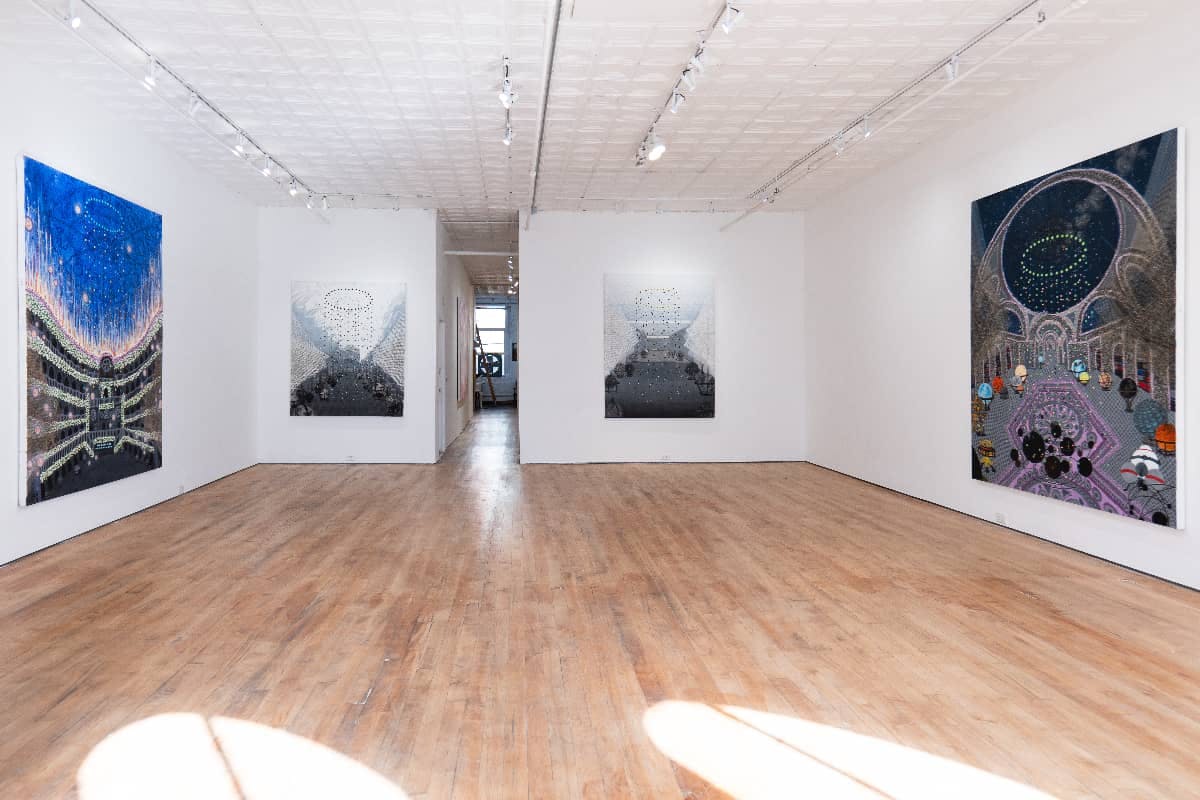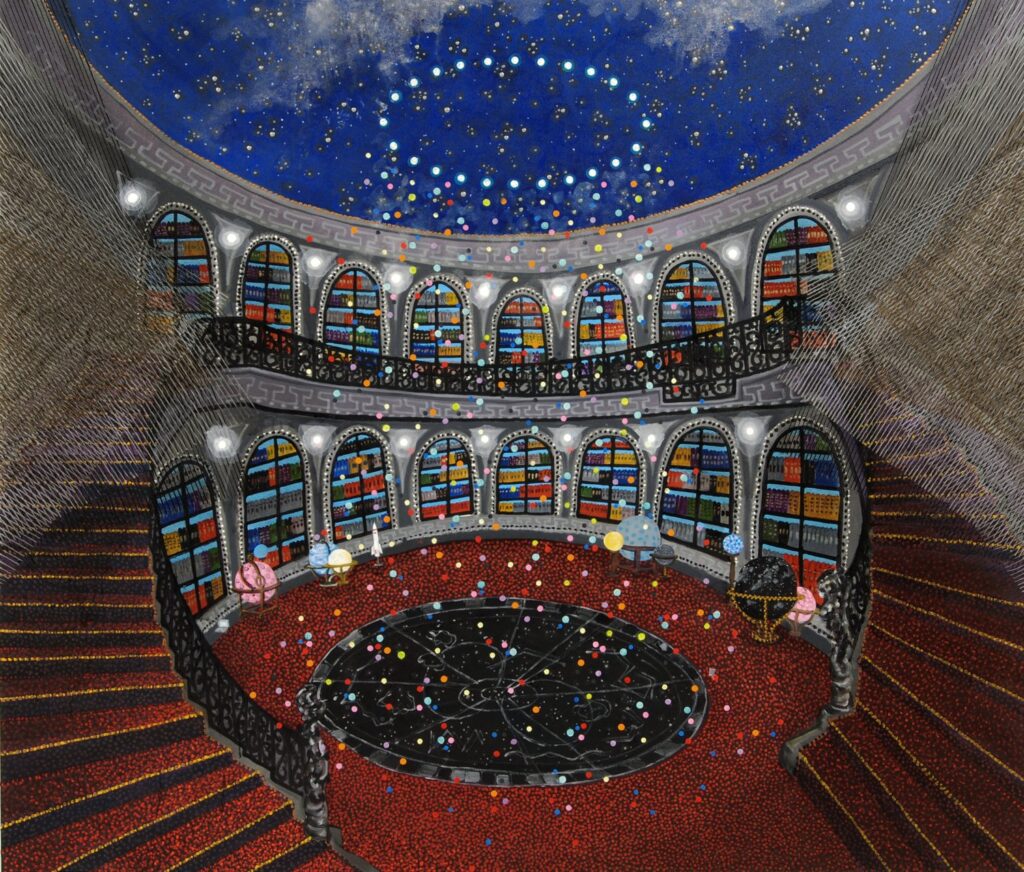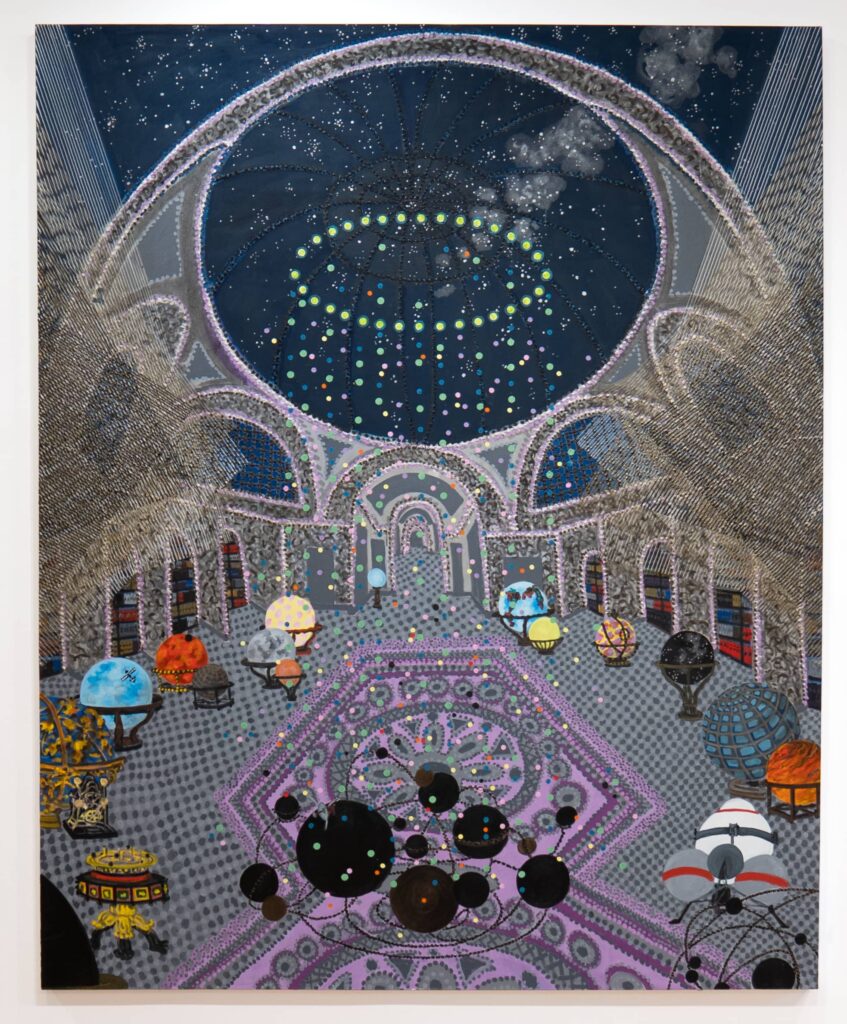Michiko Itatani’s Celestial Interiors, Replete With Earthly and Otherworldly Wonder
In the artist’s solo New York debut at a new Tribeca art gallery, Storage, her paintings don’t tell stories so much as evoke dream worlds where stories can happen.

Michiko Itatani: ‘Cosmic Encounters‘
Storage, 52 Walker Street, 4th floor, New York, NY
Through December 30, 2023
What does heaven look like? The celestial interiors of Michiko Itatani, replete with earthly and otherworldly wonder, offer one possible glimpse. In Ms. Itatani’s solo New York debut at a new Tribeca gallery, Storage, her canvases imbue the entire space with their own peculiar brand of cosmic serenity.
At first glance, Ms. Itatani’s works appear to be faithful renditions of collective spaces, or spaces made for human gathering. They show cathedrals and temples, theaters, ballrooms and opera houses, concert halls, and grand libraries. There are sweeping staircases, large chandeliers, and box seats, shelves of books and scientific instruments, decorative ceilings, and tiled floors.
Only upon further examination does the metaphysical dimension of each interior reveal itself through a wealth of whimsical detail. Archways open directly onto deep space, portholes filled with stars appear in the floors and ceilings, luminous motes of stardust float everywhere, giving every painting an eerie glow.

It has often been said that Ms. Itatani, who is also a writer, imbues her painting with a narrative quality. If they do suggest a story, however, it is only the off-beat sense of much contemporary Japanese writing. One is reminded of the uncanny fiction of Haruki Murakami or Edagawa Ranpo.
Her paintings don’t tell stories so much as evoke dream worlds where stories can happen. Her emphasis is on strangeness and possibility, offering places for the eye and mind to travel. Each painting is a sublime storybook world that invites the viewer to enter the mysteries of inner and outer space.
“Cosmic Wanderlust”, for example, leaves it unclear whether the ceiling or floor are windows or portals into another dimension. The large circle in the ceiling could be a painted dome, or it could be a window into deep cosmic space. The circle of pale greenish orbs set within it could either be a chandelier or a circle of stars. In “Bluelift,” the pretence to human architecture is almost suspended, where the shell-like motifs of the ceiling could be the vaults of a vast alien hanger and the chandeliers celestial ships floating toward it.

Scientific knowledge and childlike wonder, architectural detail and the purely fantastical: Ms. Itatani makes these contrasting elements blend seamlessly in a way that makes it seem perfectly plausible. The viewer is called upon to innocently believe, and that is what gives each painting its magic.
Though Ms. Itatani has referred to herself as an “American made artist,” there is something deeply Japanese in the naive orderliness of her canvases. You get the sense that she is striving to convey the Japanese principle of Wa or harmony.
It explains Ms. Itatani’s choice of spaces devoted to harmonious pursuits, to cultural spaces where the enjoyment of beauty and the preservation of knowledge are prioritized. Though people are not present in her paintings, their collective cultural presence is in every detail, as are their collective ideals.
She is also making a statement about the inherent limits of outer and inner knowledge. As she has said in interviews, humanity’s knowledge of the material universe only extends so far before it hits a wall of absolute mystery.
An investigation into inner space reveals a similar limit. However elaborate and detailed our explorations may be, we must always surrender to the failure of knowledge, beyond which once can only wonder.
Originally from Osaka, Japan, Ms. Itatani came to the United States in search of artistic freedom and opportunity, just like her fellow Japanese artists Yayoi Kusama and Yoko Ono. Though Ms. Itatani chose Chicago randomly by pointing her finger at a map of the United States, the city has helped her flourish.
She was rapidly incorporated into the Chicago art scene of the early 1970s, eventually earning her MFA at the Chicago Art Institute in 1973. She returned in 1979 as a faculty member in the painting and drawing department and has taught there ever since. Her reputation as a “quiet giant” of the Chicago painting scene has only grown since then.
Ms. Itatani’s current show at Storage, organized by up-and-coming curator Onyedika Chuke, is a strong summation of the artist’s mature work of the last five years, a full flowering of her benign, perhaps even mystical vision of idealized worlds devoted to the pursuit of knowledge, science, and beauty.

